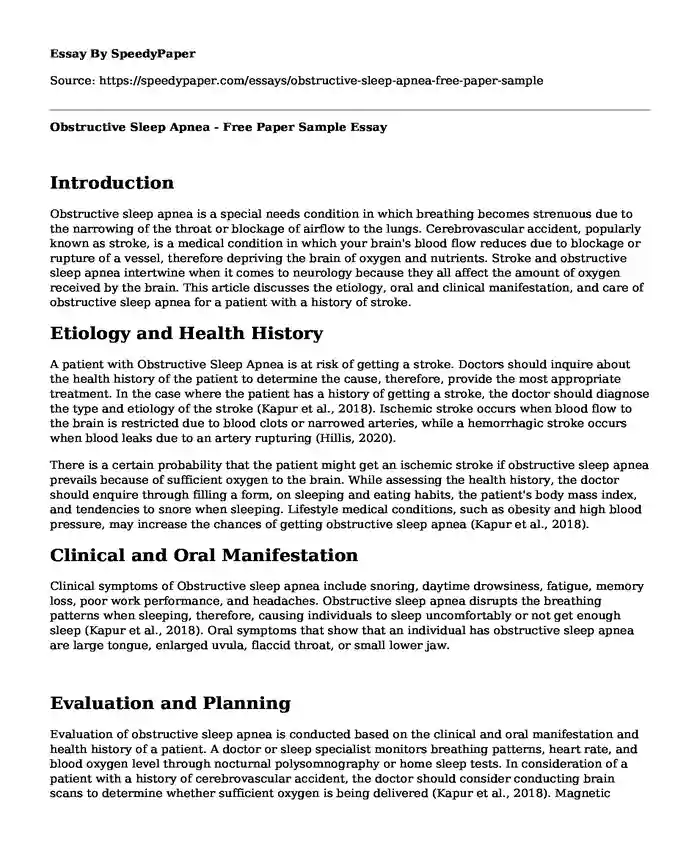
| Type of paper: | Essay |
| Categories: | Healthcare |
| Pages: | 3 |
| Wordcount: | 736 words |
Introduction
Obstructive sleep apnea is a special needs condition in which breathing becomes strenuous due to the narrowing of the throat or blockage of airflow to the lungs. Cerebrovascular accident, popularly known as stroke, is a medical condition in which your brain's blood flow reduces due to blockage or rupture of a vessel, therefore depriving the brain of oxygen and nutrients. Stroke and obstructive sleep apnea intertwine when it comes to neurology because they all affect the amount of oxygen received by the brain. This article discusses the etiology, oral and clinical manifestation, and care of obstructive sleep apnea for a patient with a history of stroke.
Etiology and Health History
A patient with Obstructive Sleep Apnea is at risk of getting a stroke. Doctors should inquire about the health history of the patient to determine the cause, therefore, provide the most appropriate treatment. In the case where the patient has a history of getting a stroke, the doctor should diagnose the type and etiology of the stroke (Kapur et al., 2018). Ischemic stroke occurs when blood flow to the brain is restricted due to blood clots or narrowed arteries, while a hemorrhagic stroke occurs when blood leaks due to an artery rupturing (Hillis, 2020).
There is a certain probability that the patient might get an ischemic stroke if obstructive sleep apnea prevails because of sufficient oxygen to the brain. While assessing the health history, the doctor should enquire through filling a form, on sleeping and eating habits, the patient's body mass index, and tendencies to snore when sleeping. Lifestyle medical conditions, such as obesity and high blood pressure, may increase the chances of getting obstructive sleep apnea (Kapur et al., 2018).
Clinical and Oral Manifestation
Clinical symptoms of Obstructive sleep apnea include snoring, daytime drowsiness, fatigue, memory loss, poor work performance, and headaches. Obstructive sleep apnea disrupts the breathing patterns when sleeping, therefore, causing individuals to sleep uncomfortably or not get enough sleep (Kapur et al., 2018). Oral symptoms that show that an individual has obstructive sleep apnea are large tongue, enlarged uvula, flaccid throat, or small lower jaw.
Evaluation and Planning
Evaluation of obstructive sleep apnea is conducted based on the clinical and oral manifestation and health history of a patient. A doctor or sleep specialist monitors breathing patterns, heart rate, and blood oxygen level through nocturnal polysomnography or home sleep tests. In consideration of a patient with a history of cerebrovascular accident, the doctor should consider conducting brain scans to determine whether sufficient oxygen is being delivered (Kapur et al., 2018). Magnetic resonance imaging is a stroke evaluative test that focuses resonance on brain organs, vessels, and tissues hence evaluating neurological activity (Mcfarlane, 2018).
Clinical and Oral Care
Doctors can recommend surgery to reposition the jaw. The doctor may recommend therapies like bi-level positive airway pressure, continuous positive airway pressure, which convey air pressure via a mask hence ensuring the airway always demands air due to pressure imbalance with the surrounding. These air pressure therapies are the most commonly used to treat obstructive sleep apnea. Medical specialists may also recommend an oral appliance that ensures the airway inside the throat is open by aligning the jaws (Kapur et al., 2018).
Conclusion
Patients with obstructive sleep apnea have a higher chance of getting an ischemic stroke if they have a history of stroke. Clinical and oral symptoms of obstructive sleep apnea include snoring, daytime drowsiness, fatigue, poor work performance and headaches, large tongue, enlarged uvula, flaccid throat, or small lower jaw. Assessment of health history and evaluation of obstructive sleep apnea is necessary to determine the right treatment procedures. Obstructive sleep apnea is treatable through bi-level positive airway pressure, continuous positive airway pressure and oral appliance.
References
Fuller, S. L. (n.d.). Diagnosing Sleep Apnea: Dentist in Greensboro NC.
https://www.sandrafullerdds.com/care-and-comfort/diagnosing-sleep-apnea/
Hillis, A. (2020). Developments in treating the nonmotor symptoms of stroke. Expert Review Of Neurotherapeutics, 20(6), 567-576.
https://doi.org/10.1080/14737175.2020.1763173
Kapur, V., Auckley, D., Chowdhuri, S., Kuhlmann, D., Mehra, R., Ramar, K., & Harrod, C. (2017). Clinical Practice Guideline for Diagnostic Testing for Adult Obstructive Sleep Apnea: An American Academy of Sleep Medicine Clinical Practice Guideline. Journal Of Clinical Sleep Medicine, 13(03), 479-504.
https://doi.org/10.5664/jcsm.6506Mc
Farlane, S. (2018). Obstructive sleep apnea and stroke. Sleep Medicine And Disorders: International Journal, 2(5). https://doi.org/10.15406/smdij.2018.02.00056
Naminik, D. (2018, March 09). What Causes Sleep Apnea?: Woodland Hills, CA. https://woodlandhillsdentalarts.com/what-causes-sleep-apnea/.
Cite this page
Obstructive Sleep Apnea - Free Paper Sample. (2023, Nov 10). Retrieved from https://speedypaper.com/essays/obstructive-sleep-apnea-free-paper-sample
Request Removal
If you are the original author of this essay and no longer wish to have it published on the SpeedyPaper website, please click below to request its removal:
- Essay Example on the Diffusion of Innovation Theory
- Free Essay Example on Blood Transfusions
- Free Essay on the Article: Overview and Findings from the Rush Memory and Aging Project
- Essay Sample with the Focused Assessment: Behavioral and Mental Health
- Research Notebook
- Essay Example: Substance Abuse Effects on Neonate
- Osteoporosis Health Literacy - Free Paper Example
Popular categories




